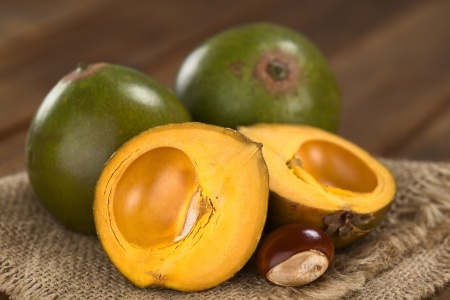Lucuma - Pouteria lucuma

Common Names: Lucuma, Lukuma, Eggfruit, Lucmo, Teissa, Canistel, Pouteria lucuma, Pouteria campechiana, Lucuma obovata, Global: Lucuma (English, Spanish, international), Inca Gold Fruit, Andean Eggfruit
Latin Name: Pouteria lucuma
Origin: South America
Short Introduction
Lucuma is specifically cultivated in tropical and subtropical regions, primarily growing in South America and the southern parts of North America. While originating from tropical areas, lucuma is technically considered a subtropical plant due to its preferred temperature ranges. It propagates through seeds and thrives best in warmer climates, yet it tolerates cooler temperatures as well. Lucuma requires full sun and as much light exposure as possible. Regular watering is beneficial, but in dry conditions, lucuma adapts quickly and usually survives periods of drought.
Lucuma has been successfully planted in the subtropical foothills of California, though attempts to grow it in Florida have been unsuccessful. In Central and South America, countries like Peru and Ecuador are major producers, with Bolivia and Costa Rica also contributing to the global lucuma trade. While lucuma prospers in tropical regions, it is not widely cultivated there; however, it is found in abundance in Laos and Vietnam. The plant grows best at elevations between 1000 and 2400 meters above sea level. Harvest season is from October to March in Peru and from June to November in Chile.
Detailed Description
The historic gold of the Incas with many healing properties.
Botanical Information
Lucuma is a medium-sized tree, typically reaching a height of 7 to 10 meters, but with optimal growing conditions can grow up to 15 meters tall. The fruit of the lucuma has a very dry flesh with a unique taste often described as reminiscent of maple and sweet potato. Its fruit is round or oval, green on the outside, and the flesh is light yellow, fibrous, and interlaced with fine tissue strands.
Origin and Distribution
Lucuma is native to the Andean valleys of South America, spanning present-day Chile, Ecuador, and Peru. Evidence of lucuma has been discovered in decorative artwork on pottery and ritual artifacts at tombs and ceremonial sites of indigenous peoples. For example, the Moche tribe was so fascinated and inspired by the surrounding nature that fruits like lucuma became woven into their folk culture and especially their art. Lucuma was first encountered and admired by Europeans in the Chinchasuyu region of the powerful Incan Empire in 1531.
Usage / Dosage
Known as the "Gold of the Incas" due to its high value, lucuma was once exchanged for gold. Research from Rutgers University in New Jersey highlights lucuma's active compounds as possessing significant anti-inflammatory effects, contributing to wound healing and tissue regeneration. These compounds also play a crucial role in preventing premature aging. The fatty acids present in lucuma’s lipid content are well-suited for topical skin application, supporting barrier protection and epithelial regeneration.
Scientific literature also notes lucuma’s lipid content for its ability to accelerate the healing of mild to moderate skin injuries and damaged tissue. Lucuma’s active ingredients have shown potential antihyperglycemic and antihypertensive effects, indicating possible support in lowering high blood sugar levels and reducing high arterial blood pressure, though the effect on pressure is considered mild.
Lucuma is recommended as a healthy, natural sweetener (with added fiber content). Its flavor is often compared to vanilla blended with maple syrup, making it a popular addition in home-made desserts, cakes, ice creams, fruit smoothies, compotes, porridges, or cereals—ideal for sweet dishes. It suits not only athletes but also those following dietary restrictions (e.g., diabetics). Lucuma is highly nutritious and delicious, and can be consumed without limitation (especially by children and seniors). It contains no sugar or artificial additives.
Mixing powdered lucuma with water or milk can sometimes be difficult due to its high content of insoluble fiber. To avoid lumps, it is best to pre-blend the powder separately, or mix with other ingredients before diluting. A shaker can also be used together with pieces of fruit or other ingredients.
Active Compounds
Lucuma fruit is highly nutritious, containing substantial amounts of beta-carotene, vitamin B3 (niacin), and other B vitamins. It is also rich in carbohydrates, dietary fiber, and minerals—especially potassium, iron, calcium, and phosphorus. Fatty acids are present in significant amounts, mainly linoleic, oleic, palmitic, stearic, and linolenic acids. These compounds have been shown to notably support the migration and expression of immune cells and fibroblasts, underlying lucuma’s well-documented anti-inflammatory activity.
Traditional Dosage
For traditional use, place the desired amount of powdered lucuma in a container, add double the amount of water, and mix thoroughly until a dense paste forms. This homogenous paste can then be diluted with liquid to preferred consistency and taste. Add water slowly while mixing to prevent clumping. One recipe describes mixing 4 tablespoons of lucuma powder with warm plant-based or cow’s milk, stirring, and letting the mixture swell for about 5 minutes before adding slices of fresh fruit (such as bananas, strawberries, apples) as desired. Sweeten if preferred. This mixture can also be added to cereals, yogurt, and more.
